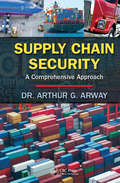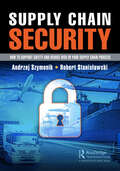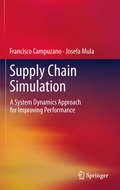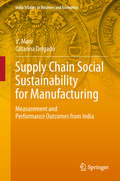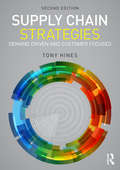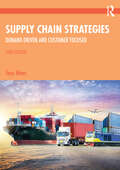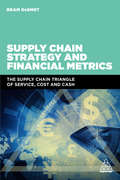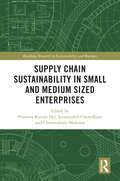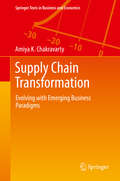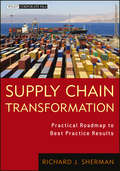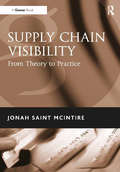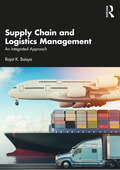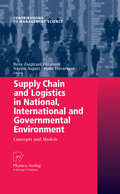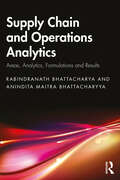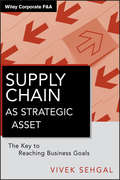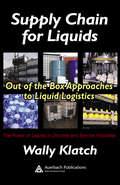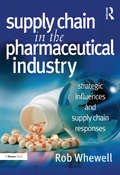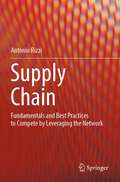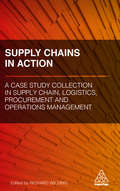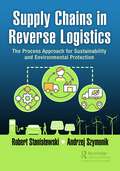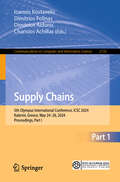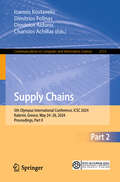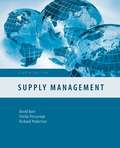- Table View
- List View
Supply Chain Security: A Comprehensive Approach
by Arthur G. ArwayThe supply chain is a complex system of numerous, integrated stakeholders. These stakeholders are responsible for the transportation, storage, documentation, and handling of material goods and cargo. Each entity has its own unique relationship with and role within the chain as well as its own unique security requirements. The challenge of trying to
Supply Chain Security: How to Support Safety and Reduce Risk In Your Supply Chain Process
by Andrzej Szymonik Robert StanisławskiContemporary supply chains operate under the pressure of customer requirements, increasing price competition, sudden increases or decreases in demand, unforeseen obstacles and new threats. The right way to improve the functioning of the flow of material and accompanying information is not only the continuous collection of data but also their collection, analysis, inference and decision-making with the use of decision support systems, expert systems and artificial intelligence. Such procedures make it easier for logisticians not only to forecast processes but also to predict (forecast) and identify potential problems and facilitate the implementation of optimal modern solutions, paying attention to current trends in the supply chain market. An important issue that affects the quality, efficiency and availability (continuity) of the processes implemented within the supply chain is security. This is an area that is not clearly defined. This book uses theoretical and practical knowledge to define security in the supply chain as a state that gives a sense of certainty and guarantees the flow of material goods and services (in accordance with the 7w rule) as well as a smooth flow of information for the planning and management of logistics processes. Tools and instruments used to ensure the security of the supply chain contribute to the protection and survival in times of dangerous situations (threats) and adaptation to new conditions (susceptibility to unplanned situations). When analyzing the needs and structure of the 21st century supply chains, in the context of their security, it is impossible to ignore the problem of their digitization, which enables the determination of optimal routes and the anticipation of possible threats (crisis situations). Automatic data exchange between various departments of the company along the upper and lower part of the supply chain improves the functioning of the warehouse management through, among others, automation, robotization and pro-activity. It also contributes to efficient, good communication and market globalization. Automation also brings new, extremely attractive business models with regard to occupational safety, ergonomics and environmental protection. To meet the needs of creating modern supply chains, the book analyzes and presents current and future solutions that affect security and the continuity of supply chains.
Supply Chain Simulation
by Francisco Campuzano Josefa MulaSupply Chain Simulation allows readers to practice modeling and simulating a multi-level supply chain. The chapters are a combination of the practical and the theoretical, covering: knowledge of simulation methods and techniques,the conceptual framework of a typical supply chain,the main concepts of system dynamics, anda set of practice problems with their corresponding solutions.The problem set includes illustrations and graphs relating to the simulation results of the Vensim® program, the main code of which is also provided. The examples used are a valuable simulation tool that can be modified and extended according to user requirements. The objective of Supply Chain Simulation is to meet the demands of supply chain simulation or similar courses taught at the postgraduate level. The "what if" analysis recreates different simulation scenarios to improve the decision-making process in terms of supply chain performance, making the book useful not only for postgraduate students, but also for industrial practitioners.
Supply Chain Social Sustainability for Manufacturing: Measurement and Performance Outcomes from India (India Studies in Business and Economics)
by V. Mani Catarina DelgadoThis book highlights a number of social sustainability issues at different stages of the supply chain, and demonstrates how these issues can be addressed by adopting social sustainability practices in the manufacturing supply chain. In the wake of emerging social issues in developing countries, research on social sustainability has gained importance for academics and practitioners alike. The three distinguishable social sustainability dimensions in manufacturing that emerge as a result of this research provide insights for supply chain managers and practitioners who might otherwise be unaware of what constitutes social sustainability. A better understanding allows supply chain managers to address these issues more appropriately to increase their supply chain competitiveness in the market. The book presents a social sustainability scale that can be used by practitioners to measure supply chain social sustainability to benchmark their supply chains globally. The research also helps academicians to gain an understanding of the social issues related to the manufacturing supply chain, while the social measures developed serve as reference material for policy-makers and sustainability experts in emerging economies.
Supply Chain Strategies: Demand Driven and Customer Focused
by Tony HinesSupply Chain Strategies demonstrates how organizations must take strategic decisions in order to manage their supply chains to sustain competitiveness in the global economy. Whereas many textbooks on supply chain management focus on purchasing and operations, this new edition of Tony Hines' text focuses upon the direction-setting and efficient resource-allocation that organizations need to provide in order to satisfy their customers. Overcoming tensions between political, economic, technological, ethical and environmental considerations is shown to be vital to ensure a sensible strategy for managing the supply chain. This impressive text makes the most of integrated case studies to show how strategic thinking and supply chain management play out in the real world. As such, the book is ideal for courses on supply chain management - especially those which require a strategic element.
Supply Chain Strategies: Demand Driven and Customer Focused
by Tony HinesSupply Chain Strategies demonstrates how organizations must take strategic decisions in order to manage their supply chains to sustain competitiveness in the global economy. Whereas many textbooks on supply chain management focus on purchasing and operations, this new edition of Tony Hines’ text focuses upon the direction-setting and efficient resource-allocation that organizations need to provide in order to satisfy their customers. Overcoming tensions between political, economic, technological, ethical and environmental considerations is shown to be vital to develop effective strategies for managing the supply chain. The third edition of Tony Hines’ successful textbook integrates thoroughly updated international cases to demonstrate how strategic thinking and SCM play out in the real world, and contains a host of useful pedagogy to reinforce learning, including learning outcomes for each chapter, discussion questions and a handy glossary. New to this edition are chapters discussing supply chain risk, procurement strategies and supply chain futures. This book is ideal for courses on supply chain management – especially those that require a strategic element.
Supply Chain Strategy and Financial Metrics: The Supply Chain Triangle Of Service, Cost And Cash
by Dr Bram DeSmetSupply Chain Strategy and Financial Metrics is a step-by-step guide to balancing the triangle of service, cost and cash which is the essence of supply chain management. Supply chains have become increasingly strategy-driven, and this Supply Chain Triangle approach puts the supply chain at the heart of the strategy discussion instead of seeing it as a result. Supply Chain Strategy and Financial Metrics fully reflects the 'inventory' or 'working capital' angle and examines the optimisation of the supply chain and Return on Capital Employed. Including case studies of Barco, Casio and a selection of food retail companies, this book covers building a strategy-driven KPI dashboard, target setting and financial benchmarking. Regular examples and diagrams illustrate how different types of strategies lead to different trade-offs in the Supply Chain Triangle. This ground-breaking text links supply chain, strategy and finance through financial metrics, therefore creating value for the shareholder.
Supply Chain Sustainability in Small and Medium Sized Enterprises (Routledge Research in Sustainability and Business)
by Prasanta Kumar Dey, Soumyadeb Chowdhury and Chrisovaladis MalesiosThis book examines the sustainability of supply chains in small and medium sized enterprises (SMEs), in developed and emerging economies. Drawing on contributions from experts in the field and examining case studies from a range of countries, including Thailand, Bangladesh, France, Spain, Austria and Greece, this book provides researchers and industry practitioners with guidance on how to make SMEs more sustainable through appropriate trade-offs between economic, environmental and social aspects. Over the course of the book, the authors examine the current state of sustainable supply chain practices, highlight the key issues and challenges, and identify critical success factors across different industries and geographical locations. They also explore how supply chain carbon footprints and effectiveness are measured, and navigate the delicate balance between reducing the carbon footprint whilst still ensuring enhanced productivity. Finally, the book reflects on how the circular economy model might facilitate higher sustainability of SMEs. Supply Chain Sustainability in Small and Medium Sized Enterprises will be of great interest to scholars and practitioners of supply chain management and sustainable business.
Supply Chain Transformation
by Amiya K. ChakravartyToday, supply chain transformation for creating customer value continues to be a priority for many companies, as it enables them to gain a competitive advantage. While value creation is shaped by external drivers such as market volatility, technology, product and service offering and disruption, it can be stymied by the internal stresses arising from the need to minimize costs, limitations in process redesign, waste minimization and the unavailability of knowledge capital. Therefore, for companies to survive and prosper, the relevant questions to ask would be how to identify the external/internal forces driving changes and how to map the business drivers to the attributes of transformation. While the contemporary supply chain is well-structured, the evolving economic system is causing disruptions to this structure. The emergence of novel business paradigms - non applicability of the traditional laws of supply and demand, dominance of negative externality effects and anomalies of high growth rate coexisting with high supply side uncertainty - must be recognized in transforming supply chains. For example, healthcare delivery and humanitarian relief do not follow known supply/demand relationships; the negative externality effects are increasing sustainability concerns; and emerging economies, with dysfunctional business infrastructure, must manage high growth rates. This book delves into the transformation issues in supply chains and extends the concepts to incorporate emerging issues. It does so through ten chapters, divided into three sections. The first section establishes the framework for transformation, while the second focuses on the transformation of current chains in terms of products, processes, supply base, procurement, logistics and fulfillment. Section three is devoted to capturing the key issues in transforming supply chains for emerging economies, humanitarian relief, sustainability and healthcare delivery. This work will be of interest to both academics and industrial practitioners and will be of great value to graduate students in business and engineering. It raises many questions, some provocative and provides many leads for in-depth research. Several approaches are suggested for new problems along with a discussion of case studies and examples from different industries.
Supply Chain Transformation: Practical Roadmap to Best Practice Results (Wiley Corporate F&A #629)
by Richard J. ShermanAchieve best practices in supply chain management Much is being written about global supply chain and sourcing options emerging in today's marketplace. Transforming supply chain management to achieve operations excellence is a mandate for many companies globally. Supply Chain Transformation walks you through this potentially difficult process and gets you started on the journey. Much more than just a how-to book, it's a why-to book that is as compelling for any business person as it is for supply chain management professionals. This book provides an invaluable road map to companies looking to transform their supply chains and organizations to achieve best practice results, beginning with guidance on how to make the case for change. Change is inevitable; growth is optional. Includes real world cases and illustrations Offers a step-by-step road map to transforming your supply chain Explains how to obtain "senior management" commitment to transformation Covers sourcing, production, and logistics process integration points with product development, marketing, sales, and finance processes as well as emerging technologies (RFID, Cloud computing, telematics, ERP, GPS/LBS & others) One of the biggest hurdles to supply chain transformation is overcoming a culture that is resistant to change. Supply Chain Transformation helps you understand the cultural resistance and evaluate where change is needed most, and then develop the game plan for overcoming resistance to achieve best practice results.
Supply Chain Visibility: From Theory to Practice
by Jonah Saint McIntireTransparency and accurate management information are essential if you want to ensure that the supply chain is working for your business. Supply Chain Visibility is a critical primer for readers with backgrounds in supply chain management, system integration, strategy consulting, and enterprise software. Jonah McIntire sets the stage for a new framework that empowers business leaders to connect their projects, tasks or work streams back to the strategic message that it is worth applying organizational resources to supply chain visibility. Drawing on research findings, he reviews the prerequisites needed for a successful visibility solution and suggests a visibility fitness scorecard to compare the quality of widely varying approaches. The second section of the book reviews in detail the eight most common types of supply chain visibility and offers a set of indicators of potential fit for each one. The book also explains how to acquire visibility technology and the available options, and includes guidance on best practice for in-house designed systems. If you or your organization are moving into this area, Jonah’s insights will place you in a far stronger position to decide exactly how to leverage the benefits of supply chain visibility solutions; they also walk you carefully through the minefields of ineffective approaches or technologies to give you the greatest chance of success.
Supply Chain and Logistics Management: An Integrated Approach
by Rajat BaisyaThis textbook discusses supply chain management and provides a comprehensive overview of all the key activities and issues of supply chain and logistics functions as an integrated discipline.Taking a comprehensive approach, it reviews end-to-end supply chain management from procurement to production to warehousing, distribution and customer service. It explores how each interface can be managed with the ultimate objective of providing superior customer experience to ensure satisfaction at the least cost while delivering incremental value in a competitive environment.This volume: Guides on designing effective development and management of the supply chain network, which is an invaluable source of sustainable, competitive advantage in today’s turbulent global marketplace Examines the complexities and challenges of catering to the flexible and fluctuating customer demand, warehousing, channel distribution and transportation, global logistics value chain management, and performance management Discusses short practical cases to explain the decision-making process with respect to manufacturing decisions and inventory for efficient working capital management, both of which are critical for supply chain performance Explores performance management matrix, maturity models and so on This book will be useful to students, researchers and faculty from the fields of business management, supply chain and logistics management, and mechanical and civil engineering. It will also be an invaluable companion to consultants and business executives working in the field of supply chain and logistics.
Supply Chain and Logistics in National, International and Governmental Environment: Concepts and Models
by Reza Zanjirani Farahani Nasrin Asgari Hoda DavarzaniThe main concern of this book are national and governmental supply chains, which have rarely been considered by regular publications in related disciplines. Not only are readers provided with useful information about the latest topics in supply chains; the book also helps them to track the history and related cases of each topic. This manuscript has been organized in twelve chapters, so that readers can study each chapter not only dependently but also independently. If someone wants to study the book more in-depth, the suggested sequencing in the preface can be helpful. Generally, the readers of this book can be divided into at least two groups: 1) students studying for a master degree, who can use this book in their courses as a whole, 2) experts who want to learn more about a new topic in logistics and supply chain management; this group may want to read a short chapter about a specific topic in this book.
Supply Chain and Operations Analytics: Areas, Analytics, Formulations and Results
by Rabindranath Bhattacharya Anindita Maitra BhattacharyyaThis book presents the concepts, strategies and decision-making processes of supply chain and operations management through simple to advanced analytics. It provides the tools necessary to comprehend supply chain and operations management, quantitatively and analytically, through exercises and examples.Using accessible quantitative models, the volume provides a unified framework for supply chain analytics for products – right from sourcing to manufacturing to delivery and remanufacturing, which closes the supply chain. The book synthesizes a collection of models in all areas of the supply chain – such as sourcing, inventory, production planning and control, forecasting of demand, transportation, network planning and design, data aggregation and mining, and the return of products – in the context of both the formulation and solution of the problems in each area using suitable software and Excel Solver for ease of understanding. The use of simulation and stochastic and system design models are added attractions of the book.This book will be useful to students, researchers and faculty working in the field of supply chain management, operations management and industrial engineering, both at graduate and research levels. It will also be an invaluable companion to consultants and practitioners, working with models and modelling systems, helping them to make better supply chain decisions.
Supply Chain as Strategic Asset
by Vivek SehgalHands-on guidance for creating competitive advantages through strategy realization How can your supply chain create competitive advantages and help achieve business goals? Drawing from the author's abundant research and analysis, this resourceful book shows how aligning the supply chain design with business strategy helps build competitive capabilities, prioritize capital investments, and takes your firm beyond the industry best-practices to create competitive advantages, not just competitive parity. Summarizing the current literature on business and supply chain strategies, this book provides path-breaking new direction to build your own winning supply chain strategy. Real-life cases show how this strategy alignment has produced results for the most successful companies and how it can be achieved in your firm. An overview of the concepts of business strategy, the current thinking on supply chain strategy and why it is inadequate to drive competitive advantage through supply chain design Process for establishing your own supply chain strategy to build competitive advantage The place of technology in creating business capabilities in modern corporations and why managing technology should be a core competence and an integral part of strategy planning Step-by-step direction and examples for creating strategy alignment and designing a supply chain that goes beyond supporting your operations Case studies including Wal-mart, Cemex, Kmart, HP, Dell, and others Consolidating the lessons learned along with implementation guidance, Supply Chain as Strategic Asset is the must-read road map for designing a supply chain that will be vital in achieving your business goals.
Supply Chain for Liquids: Out of the Box Approaches to Liquid Logistics (Resource Management)
by Wally KlatchSupply Chain for Liquids: Out of the Box Approaches to Liquid Logistics provides a thorough analysis of liquid logistics, a crucial but often overlooked business issue. It covers a broad range of topics including the business, operational, and technical aspects of the Supply Chain for Liquids odel, allowing readers to leverage the inherent properti
Supply Chain in Humanitarian Operations: Managing Disruption Through Intervention and Innovation (Sustainable Development Goals Series)
by Nor Aida Abdul Rahman Kamran Mahroof Juliater SimarmataThis book explores the pivotal role of humanitarian logistics and supply chain management in ensuring effective response and relief efforts during crises. It delves into the technology revolution in this field, covering emerging trends and providing in-depth knowledge on theories and applications. The book emphasizes how technology can enhance the efficiency of humanitarian logistics and supply chain operations, integrating and optimizing technology for effective aid delivery during emergencies or crises. This book highlights the vital role that humanitarian logistics and supply chain management play during crises, emphasizing recent technological advancements. It explores the key components, challenges, and innovations that enhance the effectiveness of these systems in providing timely and targeted assistance. The book also connects humanitarian logistics to several Sustainable Development Goals (SDGs), demonstrating how these efforts contribute to poverty alleviation, health, and disaster resilience. This book offers a blend of comprehensive research and high-quality outputs from reputed authors and editors. It targets doctoral, postgraduate, graduate, and final-year undergraduate students in aviation, logistics, transport, travel, and tourism studies, as well as managers and decision-makers worldwide.
Supply Chain in the Pharmaceutical Industry: Strategic Influences and Supply Chain Responses
by Rob WhewellThe pharmaceutical and healthcare industry is hugely complex because it involves so many markets, products, processes and intermediaries. It is also heavily regulated, global, and used by everyone at some stage in their life. No wonder the supply chain for delivery of healthcare services is often fragmented and understood only in discrete sections. Changes in one area impact upon the others, and environmental factors such as pricing, regulatory change or actions by competitors impact the whole supply chain in ways that are not easily understood or managed. Accelerating technology, the commoditization of healthcare, increasing demands from ageing populations all influence the approach that suppliers of pharmaceutical products and services worldwide need to take if they are to design and manage an effective supply chain that will be capable of: exploiting their intellectual property in a sustainable way; providing safe and continuous provision of drugs or devices; and sustaining with resilience, yet still be flexible and cost efficient. Supply Chain in the Pharmaceutical Industry offers the basis for organizations to develop their own blueprint for managing the opportunities and threats to the pharmaceutical supply chain. Using examples from companies and markets across the world Rob Whewell offers a very vivid picture of the developing trends for pharmaceutical companies; the customers and markets they serve and points to some of the elements that underpin sustainable pharmaceutical strategies. The current global banking and financial crisis illustrates the important role played by regulation. The healthcare industry is similar in scope, and complexity, yet the implications of error are worse - life threatening. This review of key industry parameters will provide senior executives in the industry and policy makers in healthcare with a broad perspective of the issues and illustrates an understanding of the task at hand.
Supply Chain: Fundamentals and Best Practices to Compete by Leveraging the Network
by Antonio RizziThe book examines the supply chain from different perspectives: the physical structure which it is composed of (actors, roles, infrastructures and processes), the organizational structure of the people involved (business functions and related interactions and integrations), and the manifold flows that characterize it (product flows, information flows, service flows and monetary flows). For each of these dimensions, the text thoroughly illustrates how to design and manage it, aligning supply chain performance and competitive strategies through an integrated approach, which is key to generate competitive advantage. The book covers the different topics by combining a quantitative approach typical of engineering disciplines and adopted particularly in the operational parts, with a qualitative approach which fits in the more strategic parts. This combination makes the volume suitable for both under- and post-graduate students in industrial engineering and management, as well as undergraduates or masters students confronting supply chain management from different cultural backgrounds. Industry operators and practitioners can also find useful insights, since it thoroughly describes industry best practices, especially in the food and consumer goods, fashion and apparel, pharmaceutical and healthcare sectors, stemming from author’s real life experiences in these fields.
Supply Chains in Action: A Case Study Collection in Supply Chain, Logistics, Procurement and Operations Management
by Richard WildingVolume 2 of Logistics, Supply Chain and Procurement Case Study Collection contains new case studies tackling Supply Chain and Procurement issues, aiming to provide solutions affecting a range of different businesses. Comprehensive in scope and scrupulous in detail, this collection includes actual events experienced by businesses of every size, from SMB's to some of the most successful corporations in manufacturing, transportation, maritime and other industries. Readers will discover proven tactics and innovative solutions for handling uncertainties, solving problems and circumventing risk, plus a wealth of information to guide strategy and decision making. Readers involved in logistics and supply chain management will find the Logistics, Supply Chain and Procurement Case Study Collection full of: immediate application of strategies and tactics to situations and challenges; valuable tools for testing management proficiency in crisis mitigation and resolution; independent learning modules and professional training programmes; expanded question-and-answer sections designed to measure knowledge transfer and lessons learned; engaging, topical situations highly relevant to the fields of logistics, supply chain management and operations. Students and prospective managers will learn crucial skills to meet current challenges, qualify for professional advancement and achieve success.
Supply Chains in Reverse Logistics: The Process Approach for Sustainability and Environmental Protection
by Andrzej Szymonik Robert StanisławskiCurrently, it is obvious that new types of production (Industry 4.0) are accompanying new ways of distribution, which advance logistics, physical distribution science, and even supply chain management. The changing environment for carrying out logistics activities is also important for the development of the supply chain. Care for ecology, the recent pandemic, and the situation in Ukraine are other reasons to adapt logistics to the needs of an individual customer/recipient. It would be impossible without developing an appropriate strategy and applying appropriate tools for managing supply chains in the national and international dimensions. This book specifically addresses these issues. When analyzing the needs and structure of modern supply chains, in the context of their safety and risk reduction, it is impossible to ignore the problem of digitization, which allows for logistic analysis of the company, determining optimal routes, designing logistic systems, optimizing storage processes and costs, and predicting possible threats (crisis situations) and their effects (losses). IT support, automatic data exchange, e-logistics, telematics, traceability, and chatbots between various departments of the company along the upper and lower parts of the supply chain improve the flow of material and accompanying information through automation, robotization, proactivity, and document digitization. These new trends make it possible to define logistics as modern logistics using new achievements of science and technology. Modern logistics must also consider ecological aspects in line with assumptions about protecting the environment and improving our climate. Efficiently organized reverse logistics is not without significance for ecology. It is supported by renewable energy, electric vehicles, proper education in the field of a closed economy, cleaner production, waste minimization, the use of passive infrastructure, and proper waste management that allows us to positively influence environmental protection and human health. To meet the needs of creating modern supply chains, the authors developed this powerful book in which they analyze and present current and future solutions that influence the development of these issues in modern reverse logistics.
Supply Chains, Markets and Power: Managing Buyer and Supplier Power Regimes
by Andrew Cox Paul Ireland Chris Lonsdale Joe Sanderson Glyn WatsonSupply Chains, Markets and Power takes resource-based thinking forward by stressing the need for a dynamic and entrepreneurial conception of resource acquisition and management. This book will be essential reading for all those with a professional or academic interest in supply chain management.
Supply Chains: 5th Olympus International Conference, ICSC 2024, Katerini, Greece, May 24–26, 2024, Proceedings, Part I (Communications in Computer and Information Science #2110)
by Dimitrios Aidonis Charisios Achillas Ioannis Kostavelis Dimitrios FolinasThis two-volume set constitutes the refereed proceedings of the 5th Olympus International Conference, ICSC 2024, held in Katerini, Greece, during May 24–26, 2024. The 51 full papers in this volume were carefully reviewed and selected from a total of 92 submissions. The primary objective of 5th Olympus ICSC is to offer an international platform for the presentation and publication of the latest scientific research findings in the field of Supply Chain Management. This conference provides valuable opportunities for delegates to exchange innovative ideas, establish research and business connections, and foster global partnerships for potential collaborations. We sincerely anticipate that this conference will significantly contribute to the advancement of knowledge in relevant scientific and academic domains.
Supply Chains: 5th Olympus International Conference, ICSC 2024, Katerini, Greece, May 24–26, 2024, Proceedings, Part II (Communications in Computer and Information Science #2111)
by Dimitrios Aidonis Charisios Achillas Ioannis Kostavelis Dimitrios FolinasThis two-volume set constitutes the refereed proceedings of the 5th Olympus International Conference, ICSC 2024, held in Katerini, Greece, during May 24–26, 2024. The 51 full papers in this volume were carefully reviewed and selected from a total of 92 submissions. The primary objective of 5th Olympus ICSC is to offer an international platform for the presentation and publication of the latest scientific research findings in the field of Supply Chain Management. This conference provides valuable opportunities for delegates to exchange innovative ideas, establish research and business connections, and foster global partnerships for potential collaborations. We sincerely anticipate that this conference will significantly contribute to the advancement of knowledge in relevant scientific and academic domains.
Supply Management
by David N. Burt Donald W. Dobler Sheila Petcavage Richard Pinkerton Sheila D. Petcavage Richard L. PinkertonSupply Management is a major revision of the classic text in the field of procurement. The Eighth Edition builds on the strengths of prior editions, while including state of the art coverage and enhancements to help prepare students for the globalized world of business they will enter.
